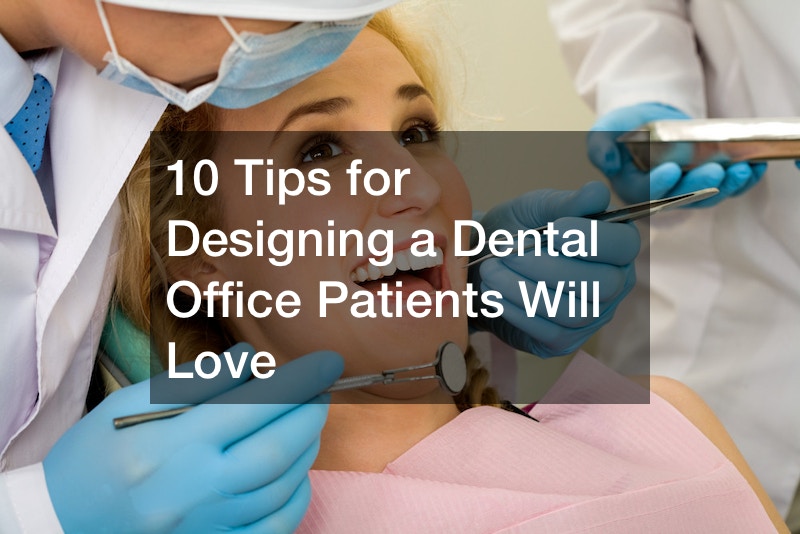
Many people, adults and children alike, hate going to the dentist and put it off as long as they can. Dental care is important so when you are designing a dental office space, you want it to end up being very warm, inviting, and friendly. The more comfortable people feel the more likely they are to come back to the dentist on a regular basis like they are supposed to, which will, in turn, give them a mouthful of healthy teeth as they grow older.
Designing a dental office that patients will love requires careful consideration of both aesthetics and functionality. A well-designed dental office can create a welcoming and comfortable environment, helping to alleviate the anxiety that many people feel when visiting the dentist.
The waiting area should not only be designed to be warm and inviting but comfortable as well. Incorporating natural light, soothing colors, and comfortable seating can create a calming atmosphere. Providing amenities like reading materials, a beverage station, and Wi-Fi access can also enhance the patient’s experience.
The treatment rooms should be designed with both the dentist and the patient in mind. Optimal ergonomics for the dental team are crucial for efficiency and patient comfort. Equipment should be modern and well-maintained while maintaining a clean and organized appearance. Thoughtful touches like overhead TVs, soothing music, or even virtual reality headsets can help distract patients during procedures.
Creating a sense of privacy is also important. Using soundproofing materials and ensuring adequate space between treatment areas can help reduce noise levels and maintain patient confidentiality. Designing separate consultation rooms allows for private discussions and a more personalized approach to treatment planning.
Incorporating technology into the dental office can significantly improve the patient’s experience. Digital appointment reminders, online scheduling, and electronic forms reduce paperwork and enhance convenience. High-speed internet and charging stations for electronic devices demonstrate a commitment to staying connected with patients.
Attention to detail is key. Paying attention to small design elements like artwork, plants, and ambient lighting can elevate the overall aesthetic and create a more pleasant environment. Ensuring cleanliness and hygiene throughout the office reinforces trust and confidence in the dental practice.
Designing a dental office that patients will love involves combining aesthetics, functionality, and comfort. By creating a welcoming atmosphere, incorporating modern technology, and attending to the small details, dental practices can enhance the patient’s experience and foster long-lasting relationships.

1. Dentist
When designing a dental office, careful consideration must be given to the comfort and efficiency of both the dentist and the patients. A well-designed dental office creates a welcoming and calming atmosphere, promoting a positive experience for patients. Adequate space should be allocated for dental chairs, equipment, and storage, ensuring ease of movement and accessibility for the dentist. Thoughtful lighting, soothing colors, and comfortable seating contribute to a relaxed ambiance. Incorporating advanced technology and ergonomic furniture enhances the dentist’s workflow and reduces fatigue. Proper ventilation and soundproofing ensure a clean and quiet environment. A thoughtfully designed dental office fosters a professional and patient-centric environment.
2. CPAP
When designing a dental office, it is essential to consider the comfort and well-being of patients, including those with sleep-related breathing disorders. Continuous Positive Airway Pressure (CPAP) is a common treatment for conditions like sleep apnea, and accommodating its use in the office can greatly benefit patients.
Incorporating CPAP-friendly features ensures a patient-centric environment. Start by providing dedicated spaces for patients to store their CPAP machines securely. This could include lockable cabinets or shelves near treatment areas. Having easily accessible power outlets in treatment rooms allows patients to conveniently plug in their CPAP devices.
Consideration should also be given to noise reduction. CPAP machines can emit low-level sounds, which can disturb both patients and dental practitioners. Soundproofing the treatment rooms or using noise-cancelling systems can help create a serene atmosphere.
Collaboration with sleep specialists and dentists with expertise in sleep medicine is crucial when designing a dental office to accommodate CPAP users. Their insights can guide the integration of appropriate ventilation systems, soundproofing materials, and electrical infrastructure to ensure a seamless and comfortable experience for patients relying on CPAP therapy. By prioritizing these design elements, dental offices can enhance patient care and cater to the needs of individuals with sleep-related breathing disorders.

3. Affordable Insurance Plan
When designing a dental office, incorporating an affordable insurance plan is crucial to ensure accessibility and comprehensive oral healthcare for patients. An affordable insurance plan can significantly impact the success and sustainability of the dental practice. By offering an affordable insurance option, patients with varying financial capabilities can receive necessary dental treatments without undue burden.
Implementing such a plan involves researching and partnering with reputable insurance providers who offer cost-effective options. The plan should cover a range of preventive, restorative, and cosmetic dental procedures, promoting overall oral health. Clearly communicating the benefits and coverage details to patients can enhance their understanding and encourage utilization of the insurance plan.
Design considerations should also reflect the affordability aspect. Utilizing cost-effective yet durable dental equipment and materials can help maintain reasonable prices for treatments. Streamlining administrative processes and adopting digital record-keeping systems can improve efficiency and reduce overhead costs, further contributing to affordability.
Ultimately, an affordable insurance plan within a well-designed dental office promotes equitable access to quality oral healthcare, fostering patient satisfaction and loyalty while establishing a reputation for patient-centered care.
4. Retainers
When designing a dental office, incorporating retainers is crucial for optimal functionality and organization. Retainers are essential components that help maintain the structural integrity and efficiency of the space.
Utilizing built-in storage and shelving units ensures that essential dental instruments and equipment, such as drills, scalers, and suction devices, are easily accessible, well-organized, and within reach of dental professionals. This promotes a seamless workflow and reduces unnecessary clutter.
Incorporating integrated cabinetry and countertops allows for efficient workspace utilization. Dentists can have designated areas for patient consultations, paperwork, and computer systems, ensuring a smooth patient experience and streamlined administrative tasks.
Strategic placement of electrical outlets, data ports, and communication systems facilitates the integration of dental technology, including X-ray machines, intraoral cameras, and dental software, maximizing efficiency and reducing cord clutter.
Thoughtful design elements like wall-mounted hooks, hangers, and trays provide convenient storage for personal protective equipment, such as gloves, masks, and lab coats, ensuring hygienic practices and promoting a clean and professional environment.
By incorporating well-designed retainers, a dental office can enhance functionality, organization, and overall productivity while creating a welcoming and efficient space for both dental professionals and patients.

5. Medical Center
When designing a dental office within a medical center, several key factors should be considered to create a functional and welcoming space. First, prioritize patient comfort by incorporating comfortable seating, calming colors, and natural lighting. Ensure adequate privacy with soundproof walls and separate treatment rooms. Equip the dental office with state-of-the-art dental equipment, including modern dental chairs, digital X-ray systems, and advanced sterilization technology. Implement efficient workflow and patient flow to maximize productivity and minimize waiting times. Additionally, create a seamless integration with the medical center by incorporating shared facilities, such as reception areas, waiting rooms, and access to medical records. Finally, prioritize accessibility by incorporating ramps, elevators, and spacious corridors for patients with disabilities.
6. Best Cosmetic Dentistry
When designing a dental office with a focus on cosmetic dentistry, several key elements should be considered to create the best environment for patients and dental professionals.
The office should have a welcoming and aesthetically pleasing ambiance. Incorporating soothing colors, comfortable furniture, and natural lighting can help create a relaxing atmosphere that puts patients at ease.
State-of-the-art equipment and technology are crucial for delivering high-quality cosmetic dental treatments. Investing in advanced imaging systems, digital scanners, and CAD/CAM technology enables precise diagnostics and accurate treatment planning.
Creating a designated area for cosmetic consultations and treatment discussions is essential. This space should provide privacy and have visual aids such as digital smile design software and before-and-after photo galleries to assist in patient communication and treatment visualization.
The dental office should also have a dedicated laboratory or a strong partnership with a reputable dental lab. This ensures efficient communication, customization, and timely delivery of cosmetic restorations like veneers or crowns.
The office should prioritize continuing education for the dental team to stay up-to-date with the latest advancements in cosmetic dentistry techniques and materials.
By incorporating these elements, a dental office can provide the best cosmetic dentistry experience for patients, fostering trust and satisfaction while achieving exceptional aesthetic results.

7. Custom Engraving
Custom engraving can add a touch of personalization and sophistication when designing a dental office. Whether it’s on signage, wall panels, or equipment, engraved elements can elevate the overall aesthetic and create a memorable impression for patients and staff alike. The use of custom engraving allows for the incorporation of dental-related motifs, such as tooth patterns or dental instruments, which adds a unique and thematic element to the space.
Engraved signage can display the practice’s name or logo, enhancing brand recognition and professionalism. Additionally, engraved wall panels can feature inspirational quotes or dental-related educational information, creating a visually appealing and informative environment.
When it comes to equipment, custom engraving can add a luxurious and exclusive feel to dental tools and instruments. Engraved handles or surfaces can bear the name of the dental practice or the dentist, adding a personal touch and promoting a sense of pride and ownership.
Custom engraving in a dental office allows for a harmonious blend of functionality and aesthetic appeal, creating a memorable and inviting atmosphere for patients while reflecting the professionalism and attention to detail of the dental practice.
8. Retractable Screen Installation
Retractable screen installation is a valuable addition to consider when designing a dental office. These screens offer numerous benefits to enhance the overall functionality and comfort of the space. Firstly, they provide excellent natural ventilation, allowing fresh air to circulate while maintaining privacy and security. The retractable feature ensures flexibility, allowing for seamless transition between open and closed configurations. By controlling sunlight and glare, these screens create a more pleasant environment for patients and staff. They contribute to energy efficiency by reducing the need for artificial lighting and air conditioning. The inclusion of retractable screens in a dental office design promotes a welcoming, well-lit, and comfortable atmosphere for everyone.
9. Preschool
When designing a dental office with a focus on preschool-aged children, several key elements should be considered. Create a welcoming and child-friendly atmosphere with vibrant colors, playful decorations, and age-appropriate furniture. Incorporate educational and interactive displays related to oral hygiene to engage young minds. Ensure that the waiting area includes books, toys, and activities to keep children entertained while they wait. Equip the treatment rooms with child-sized dental chairs, colorful murals on the walls, and ceiling-mounted TVs to distract and relax young patients during procedures. Finally, train the staff to be gentle, patient, and skilled in communicating with children to create a positive and comfortable experience.
10. Metal Roof Contractor
When designing a dentist’s office, hiring a skilled metal roof contractor is crucial to ensure both functionality and aesthetic appeal. A metal roof offers numerous advantages, making it an excellent choice for dental practices. First and foremost, metal roofs are known for their durability, providing long-lasting protection against the elements and reducing the risk of leaks or damage. This reliability is essential in maintaining a sterile environment for patients.
Metal roofs offer excellent energy efficiency, reflecting sunlight and reducing cooling costs during hot summer months. This not only benefits the environment but also contributes to cost savings for the dental office. Metal roofs can be customized to match the overall design aesthetic of the dental office, providing a sleek and modern appearance that leaves a lasting impression on patients.
By engaging a reputable metal roof contractor, dental office owners can ensure that their roofing needs are met with professionalism and expertise. From installation to maintenance, a skilled contractor will ensure that the dental office’s roof is both functional and visually appealing, contributing to a successful and efficient workspace.
Designing a dentist’s office properly is imperative for patients and staff alike. A warm and welcoming atmosphere can put people at ease when they come into your dental office.



